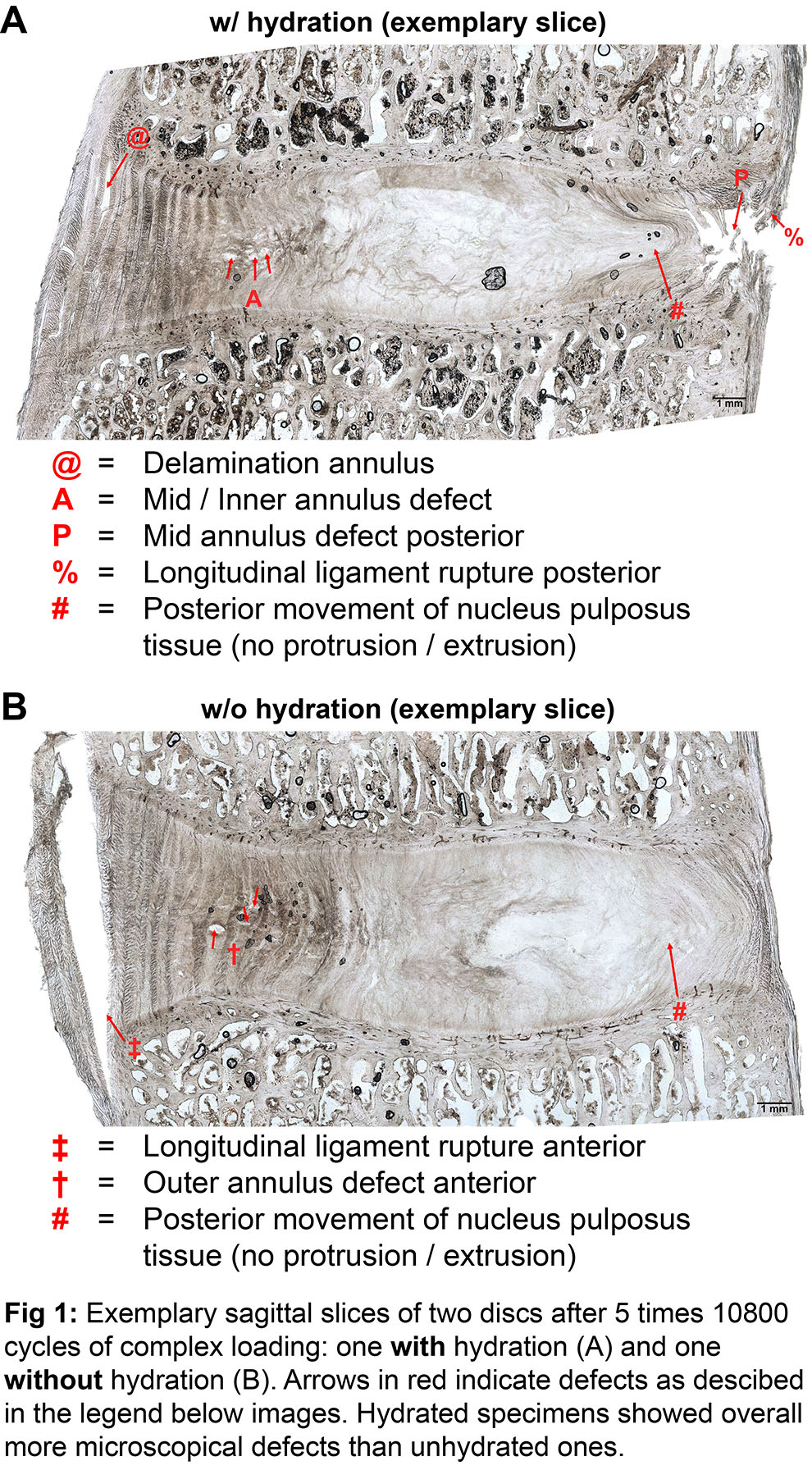Poster Presentation 51st International Society for the Study of the Lumbar Spine Annual Meeting 2025
Biomechanics and structural failure of normal vs. super-hydrated discs (#223)
Introduction. Astronauts showed to have a higher risk of intervertebral disc (IVD) herniations than the normal population (10% compared to 3.5%)1,2 This circumstance may be explained by a greater IVD swelling due to the lack of gravity in space2. The goal of the study was to investigate the influence of super-physiological IVD hydration on the biomechanical properties of discs and their structural failure mode.
Methods. Two groups of lumbar ovine motion segments were prepared and embedded in PMMA (twice n = 6). One group was hydrated between loading with distilled water (free-swelling) whereas the other not. All specimens were initially hydrated for 20 hrs. and then loaded with 10800 cycles using a complex loading protocol (3 Hz, 4° flexion, 5° lateral bending right, 1° axial rotation right, 800 N constant axial compression). This loading was repeated for four times (another 10800 each) unless a herniation occurred. The group with hydration was hydrated for 3 hrs. between the loading steps, the group without hydration not. After the five loading steps, all discs were finally hydrated for 20 hrs. and processed histologically, imaged, and checked for defects, which were classified into 12 different types similar to Wade et al.3. Intact as well as after every step, range of motion (ROM) and neutral zone (NZ) were measured (7.5 Nm, 1 °/s). Statistics: Mann-Whitney-U (p < 0.05).
Results. For IVDs that were not hydrated between the loading steps, ROM and NZ increased more and more after each loading. Hydrated IVDs recovered ROM and NZ during relaxation time with hydration (p = 1.000). After final hydration, both groups did not differ significantly in ROM and NZ (p = 0.310). Histological examination revealed that IVDs with hydration had more defects. In 4 of 6 hydrated specimens, anterior defects, damage within the nucleus, and/or delamination of the annulus occurred (Fig1A). With 2 out of 6, also more posterior longitudinal ligament ruptures were seen. For not hydrated IVDs less, isolated defects, like for example, anterior outer annulus defects occurred (Fig1B, 2 out of 6).
Discussion. Complex loading increases and hydration decreases ROM and NZ in both groups. From these biomechanical data, no damaging influence of hydration on the IVD can be concluded. However, histological examination revealed a detrimental effect of hydration, as more defects have occurred in super-hydrated IVDs than in normal IVDs. This suggests that hydrated IVDs (more common in the morning hours) may be more vulnerable to complex loading than non-hydrated IVDs. This study relies on sheep specimens, which have been demonstrated to be a reliable model for such in vitro experiments3. Thus, these results show that IVD hydration, disc height and ROM are closely linked. Furthermore, it was shown that intensive complex loading damages the microstructure of hydrated IVDs4. This study therefore is further evidence that hydrated IVDs should probably be better protected from complex loading in everyday life, e.g. avoiding demanding complex loading in the morning.
Acknowledgements. Funded by the German Research Foundation (DFG), grant number Wi1352/14-4.

- Johnston SL, Campbell MR, Scheuring R, Feiveson AH. Risk of herniated nucleus pulposus among U.S. astronauts. Aviat Space Environ Med. 2010;81(6):566-74.
- Belavy DL, Adams M, Brisby H, Cagnie B, Danneels L, Fairbank J, Hargens AR, Judex S, Scheuring RA, Sovelius R, Urban J, van Dieen JH, Wilke HJ. Disc herniations in astronauts: What causes them, and what does it tell us about herniation on earth? Eur Spine J. 2016;25(1):144-54.
- Wade KR, Robertson PA, Thambyah A, Broom ND. "Surprise" Loading in Flexion Increases the Risk of Disc Herniation Due to Annulus-Endplate Junction Failure: A Mechanical and Microstructural Investigation. Spine (Phila Pa 1976). 2015;40(12):891-901.
- Berger-Roscher N, Casaroli G, Rasche V, Villa T, Galbusera F, Wilke HJ. Influence of Complex Loading Conditions on Intervertebral Disc Failure. Spine (Phila Pa 1976). 2017;42(2):E78-E85.